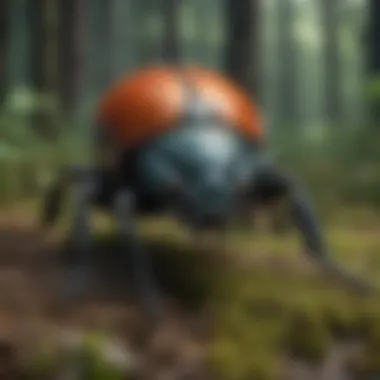Exploring the Fascinating World of Large Beetles


Intro
Large beetles represent a remarkable segment of biodiversity, encapsulating both beauty and complexity within their exoskeletal bodies. They belong to the order Coleoptera, which comprises the largest group of insects, with over 350,000 identified species. This article aims to delve into this diverse world, shedding light on distinct species of large beetles, their biological feature, ecological importance, and their interactions with various ecosystems.
Understanding large beetles is not merely an academic pursuit. It carries direct implications for conservation efforts and ecosystem management. These insects play significant roles in nutrient cycling, pollination, and pest control. Their relationships with other organisms and their habitats emphasize the interconnectedness of life.
Given this background, we will explore unique aspects of large beetle species, discussing their adaptability in different environments and the challenges they face due to human activities, climate change, and habitat destruction. The intention is to enhance awareness and foster a sense of stewardship among professionals and enthusiasts alike.
Prologue to Large Beetles
Understanding large beetles is essential in the study of biodiversity and ecosystem dynamics. These insects are not just fascinating in their own right, but they also serve various roles within their habitats. Their presence and activities contribute significantly to ecological balance. Therefore, a comprehensive look at large beetles aids in appreciating their complexities and the roles they undertake.
Defining Large Beetles
Large beetles belong to the order Coleoptera, known for its diverse species. The term "large" usually refers to those beetles that exceed a specific size threshold, often categorized by species that reach lengths of over 2 centimeters. This broad definition encompasses many families and genera that range significantly in their morphologies and behavioral patterns. For instance, the Goliath beetle, which can exceed 10 centimeters in length, is often cited as one of the largest.
Large beetles are characterized by robust bodies, hard exoskeletons, and distinct body shapes. The diversity among them is immense, with over 350,000 species described, each with unique adaptations that facilitate survival in their respective environments. Recognizing these characteristics is essential for identifying and classifying the many species within this intriguing group.
Importance in Ecosystems
Large beetles play crucial roles in maintaining the health of ecosystems in several ways:
- Decomposers: Many large beetles, such as members of the Scarabaeidae family, are vital in decomposition processes. Their feeding habits help break down organic material, returning nutrients to the soil.
- Pests and Prey: They also serve as both pests and prey in the food web. Some large beetles can damage crops, while others are essential food sources for birds and mammals.
- Pollinators: Certain species assist in pollination, although not as commonly recognized as bees.
- Indicator Species: Large beetles are often used as indicator species in ecological assessments due to their sensitivity to environmental changes. Studying their populations can provide insights into habitat integrity and the impact of climate change.
"Understanding large beetles and their ecological roles is crucial for effective conservation and management efforts."
Recognizing these functions underscores the necessity of their study. An informed appreciation of large beetles can enhance conservation initiatives and foster greater awareness in forestry and ecological undertakings.
Classification of Large Beetles
The classification of large beetles serves as a foundation to understand their diversity and complexities within ecosystems. By systematically placing these organisms into hierarchies, researchers can identify relationships among species and learn about evolutionary patterns. Understanding the classification aids in recognizing the ecological roles of large beetles and their interactions within environments. It also facilitates conservation efforts by highlighting species that may be at risk and requires attention.
Taxonomic Overview
The taxonomic framework for large beetles is categorized primarily under the order Coleoptera, which encompasses roughly 350,000 species, making it the largest order in the animal kingdom. Within this order, large beetles, or those of significant size relative to other beetle species, are further classified into families, genera, and species. This taxonomic approach is essential in differentiating species based on morphological and genetic characteristics, thus enabling proper identification and study.
Common Families of Large Beetles
Several notable families within the large beetle classification are of particular interest due to their distinct features and ecological roles.
Scarabaeidae
The Scarabaeidae family, known as the scarab beetles, is recognized for its diverse range and ecological importance. One specific aspect of Scarabaeidae is their role in decomposition. They feed on decaying organic matter, including dung, which helps in nutrient recycling within ecosystems. This family is characterized by their robust bodies and distinctive horn structures in many species, exemplifying sexual dimorphism. Their effective waste management contributes significantly to soil health and plant growth.
Unique feature: The dung ball construction behavior. This trait is instrumental in preventing the spread of parasites and diseases. However, reliance on dung sources can pose challenges in environments with limited availability.
Lucanidae
The Lucanidae family, often called stag beetles, is distinguished by their impressive mandibles which resemble antlers. These mandibles are adapted for combat during mating rituals among males, showcasing their competitive nature. Lucanidae plays a role in pollination and the breakdown of wood as many larvae develop in decaying timber.
Unique feature: The striking appearance of male stag beetles makes them popular among collectors. Yet, their dependence on specific habitats for reproduction can make them vulnerable to habitat loss.
Cerambycidae
Cerambycidae, known as longhorn beetles, are recognized for their elongated bodies and long antennae. They are primarily wood-borers, playing a critical role in breaking down dead or dying trees, facilitating the decay process. Understanding Cerambycidae is also crucial in forestry because some species can be pests, causing damage to timber resources.
Unique feature: The strong chemical cues they emit can attract mates over long distances. The downside is their attraction can lead to intensified infestations in wooden structures if conditions are conducive.


Morphological Features
The study of morphological features is crucial to understanding large beetles. These physical characteristics help reveal the evolutionary adaptations that enable beetles to thrive in diverse environments. By examining their size, coloration, and structural features, we gain insights into their ecological roles and survival strategies.
Structural Adaptations
Size Variation
Size variation among large beetles is notable. Some species can reach impressive lengths, while others remain relatively small. This variation plays a significant role in accessing different food sources and habitats. Larger beetles might compete more effectively or deter predators through their sheer size, while smaller beetles might navigate tighter spaces. Ultimately, this is about adaptability. One specific aspect of size variation is its relationship to reproductive success. Larger males typically have an advantage during mating rituals but may require more resources. However, smaller beetles can exploit niches that larger ones cannot.
Coloration and Patterns
Coloration and patterns found in large beetles exhibit both beauty and functional benefits. Many species display vivid colors or unique patterns that serve multiple purposes. Often, these features help in camouflage, allowing beetles to blend into their surroundings, which is essential for avoiding predators. Some have bright colors as a warning sign for potential threats, indicating that they may be toxic or unpalatable. Studies indicate that these adaptations contribute to both survival and mating success, which makes them essential for the discussions in this article.
Functional Anatomy
Functional anatomy encompasses the internal structures that support beetle life. Understanding these features is vital as they relate directly to the beetles' feeding, movement, and overall fitness.
Exoskeleton Composition
The exoskeleton is another key area of interest. It is primarily composed of chitin, which provides both protection and support. This strong exterior allows beetles to thrive in varied environments. Its lightweight nature facilitates movement, while being strong enough to withstand predators. However, the exoskeleton also has limitations, as it can restrict growth. When beetles mature, they must undergo molting, a process that can make them vulnerable temporarily. This unique feature is essential for understanding the life cycle of large beetles, particularly in conserving energy and protecting internal organs.
Oral Structures
Oral structures in large beetles exhibit diverse adaptations tailored to their diets. For example, some beetles have mandibles designed for crushing plant material, while others may possess more specialized mouthparts ideal for consuming wood or detritus. This specialization is a key characteristic that highlights their ecological roles. It influences what type of habitats they occupy and how effectively they contribute to nutrient cycling. In the broader context of large beetles, understanding these oral structures can guide research into their impact on ecosystems and their interactions with plant communities.
"The diversity of morphological features in large beetles illustrates their adaptations and ecological significance. Each attribute plays a role in their survival, reproduction, and interaction with ecosystems."
Behavioral Ecology
The study of behavioral ecology is vital in understanding the intricate ways in which large beetles interact with their environments. It encompasses several key aspects of their life, from how they feed to their reproductive strategies. By examining these behaviors, we will delve into their role in ecosystems and their survival tactics.
Feeding Habits
Detritivores and Herbivores
Detritivores and herbivores play essential roles in ecosystems. These beetles consume organic materials, aiding in decomposition. A prominent example is the scarab beetle, which feeds on decaying plant matter. This characteristic is significant because it highlights their contribution to nutrient recycling.
Feeding on detritus also supports soil health. The organic material broken down enriches the soil, promoting plant growth. Additionally, herbivores like the chafers consume leaves and stems, influencing plant communities. Thus, their feeding habits enhance both soil and plant health.
Predatory Behavior
Predatory behavior showcases the survival instincts of large beetles. Some species, like the stag beetle, hunt smaller insects. This behavior is crucial for controlling pest populations. Predators maintain ecological balance by regulating other species.
Moreover, their hunting techniques engage multiple senses, displaying adaptability. This trait makes them efficient foragers, ensuring their survival in various habitats. Predatory beetles also contribute to biodiversity, as they help sustain different life forms.
Mating Rituals
Display Behaviors
Display behaviors are fundamental in attracting mates. Many large beetles, such as fireflies, utilize bioluminescence to signal potential partners. This characteristic is beneficial for mate selection, ensuring genetic diversity. The ability to produce light not only captivates but also aids in mate identification.
Such behaviors can indicate the health and vitality of the individual. Thus, they play a crucial role in reproduction. However, this reliance on visual signals can be a disadvantage if environmental conditions hinder visibility.
Competition Among Males
Competition among males is common in large beetles and involves physical confrontations. Males often engage in battles to secure mating opportunities. This competitive nature is vital for understanding mating success and genetic transmission.


The size and strength of the males can influence these encounters. The strongest often prevail, which is important for their lineage. However, such competition can lead to energy depletion or injury, posing risks to survival.
Social Interactions
Territoriality
Territoriality is prevalent among certain large beetles, especially during mating season. Males assert dominance over specific areas to attract females. This behavior impacts population distribution and mating success. Territoriality can benefit individuals by ensuring access to resources and potential mates.
However, it can also lead to conflicts with other beetles. These competitions can result in injuries, limiting the territorial beetles' future chances of reproduction.
Cooperative Behaviors
Cooperative behaviors are observed in some species of large beetles. For example, certain beetles collaborate in locating food sources. This behavior fosters community relationships and can enhance survival rates. A group may work together to defend against predators or share resources.
While such cooperation can significantly improve success in finding food, it can also attract attention from larger predators. Thus, beetles must balance the risks and benefits associated with their social interactions.
Understanding behavioral ecology not only enriches our knowledge of large beetles but also emphasizes their ecological importance. By studying their complex interactions, we can better appreciate their roles in maintaining balance within ecosystems.
Habitat and Distribution
Understanding the habitat and distribution of large beetles is crucial for several reasons. These insects have established themselves in diverse environments, and their presence often indicates the health of that ecosystem. Their varied habitats directly influence their behaviors, reproductive strategies, and food sources, making it essential to study these elements in relation to their ecological roles. A comprehensive study of large beetles includes examining both their geographical range and the specific habitats they thrive in.
Geographical Range
Large beetles can be found on every continent except Antarctica, spanning various climatic zones. The factors affecting their distribution include temperature, humidity, and vegetation type. For instance, tropical regions tend to host a higher diversity of large beetles due to the warm climate and abundant food resources. In contrast, temperate zones support fewer species but may host larger individual populations due to seasonal patterns. This broad geographical range reflects the adaptability of large beetles to different environmental conditions.
Preferred Habitats
Forests
Forests are one of the most crucial habitats for large beetles. These ecosystems offer rich biodiversity, a multitude of food sources, and ideal conditions for mating and development. The key characteristic of forests is their complex structure, providing shelter and resources for numerous beetle species. The unique features of forests, such as dead wood and leaf litter, create microhabitats that are highly beneficial for the larvae of many large beetles, allowing them to thrive in a protective and resource-rich environment. However, forests also face threats like deforestation, which can dramatically reduce beetle populations.
Grasslands
Grasslands present another important habitat for large beetles. These areas typically host grasses and flowering plants, which serve as primary food sources for many beetles. The key characteristic of grasslands is their open landscape, which allows for easy movement and interaction between species. A unique feature of grasslands is their seasonal changes; they often go through cycles of growth and dormancy. This can impact beetle populations, as the availability of food varies. Grasslands might not offer the same shelter as forested areas but can support many beetle species that are adapted to open environments.
Urban Environments
Lastly, urban environments provide a contrasting habitat for large beetles. These regions demonstrate that beetles can adapt to human-influenced spaces. The key characteristic of urban areas is the presence of green spaces such as parks and gardens, which may support a surprising diversity of beetles. A unique feature of urban environments is the availability of food from discarded organic materials and landscape plants. However, urban habitats can also pose challenges, such as pollution and habitat fragmentation, which may hinder the growth and distribution of beetle populations.
In summary, the habitats of large beetles play an important role in their ecological functions and evolution, and understanding these environments helps in conservation efforts.
Role in Forest Ecosystems
Large beetles play a vital role in forest ecosystems, influencing both ecological balance and health. Their contribution extends beyond their mere existence; they actively participate in processes that are crucial for sustaining the environment. Understanding the intricate relationships between these beetles and their habitats can provide insights into forest management and conservation strategies.
Decomposition Processes
One of the significant functions of large beetles is their role in decomposition. These insects feed on dead organic matter, including fallen trees, leaf litter, and decaying plants. By breaking down this material, they facilitate the recycling of nutrients back into the soil. This process is essential as it promotes soil health and supports plant growth. Large beetles such as the Scolytus species are often seen burrowing into wood, speeding up the decomposition of dead trees, which otherwise would take many years to decay naturally.
The efficiency of large beetles in decomposition can have remarkable benefits for the forest ecosystem:
- Nutrient Release: As beetles consume dead matter, they help release nutrients like nitrogen and phosphorus into the soil.
- Habitat Creation: The breakdown of decaying material creates microhabitats for other organisms, fostering biodiversity.
- Soil Aeration: Their burrowing behavior aids in soil aeration, enhancing water infiltration and root accessibility for plants.
These contributions emphasize the importance of maintaining healthy populations of large beetles within forest environments.
Nutrient Cycling


Nutrient cycling is another critical aspect that highlights large beetles' ecological role. By participating in decomposition, these beetles assist in nutrient cycling, which is fundamental for ecosystem dynamics. After beetles break down organic materials, beneficial bacteria and fungi further decompose these nutrients, making them available for plant uptake.
The process of nutrient cycling includes several key aspects:
- Transfer of Nutrients: After decomposition, nutrients are stored in plants and then transferred to herbivores, forming a fundamental food web.
- Enhanced Soil Fertility: Continuous nutrient cycling results in improved soil fertility, promoting healthy plant communities, which in turn support diverse wildlife.
- Resilience: Healthy nutrient cycling processes enhance forest resilience against disturbances like diseases and climate change.
"The intricate web of life in forest ecosystems relies heavily on the often-overlooked contributions of large beetles. Their roles in decomposition and nutrient cycling are fundamental for ecological stability."
Understanding beetles in this context is crucial for forestry professionals and conservationists as they work towards maintaining not just individual species but the health of entire forest ecosystems.
Conservation Issues
Conservation issues surrounding large beetles are critical to understand, as they directly impact several ecosystem functions and services. Large beetles play significant roles in decomposition, nutrient cycling, and soil health, among other things. With increasing pressures from human activities, the conservation of these vital insects has become a pressing concern. Knowledge about their status and the threats they face can inform better management practices and foster awareness about biodiversity preservation. This section will discuss the main threats to large beetles and outline effective conservation strategies.
Threats to Large Beetles
Habitat Loss
Habitat loss stands as one of the most significant threats to large beetle populations. Urbanization, deforestation, and agricultural expansion lead to the destruction of their natural habitats. This loss reduces the availability of food sources and nesting sites, ultimately impacting beetle populations. A key characteristic of habitat loss is its rapid pace. Urban developments often replace forests and grasslands within a short timeframe, limiting the opportunities for beetles to adapt or relocate.
The unique feature of habitat loss is its ripple effect on the ecosystem. It creates a domino effect, disrupting not only beetle populations but also other species that depend on the same environments. The disadvantages of this threat are many, as it not only leads to reduced biodiversity but can also decrease the resilience of ecosystems. This highlights the importance of awareness and sustainable land-use practices among stakeholders in forestry, urban planning, and agriculture.
Climate Change
Climate change presents another critical challenge to large beetles. Rising temperatures and changing precipitation patterns can alter their habitats. For instance, some species may find their preferred environments unsuitable, forcing them to migrate or adapt. A key characteristic of climate change is its global reach and complex nature. This makes it a popular area of research in conservation biology, as the effects vary regionally and require targeted responses.
The unique feature of climate change in relation to large beetles is how it impacts their life cycles and behaviors. For instance, temperature fluctuations can disrupt mating rituals or feeding habits. The advantages of understanding these effects include the potential for conservation strategies that incorporate climate predictions, thus enhancing the efficacy of protection efforts. However, the disadvantages lie in the uncertain timelines and potential unpredictability of ecological responses, complicating conservation plans.
Conservation Strategies
Research Initiatives
Research initiatives form a cornerstone for understanding large beetles and their conservation needs. These initiatives can include ecological studies, population monitoring, and biodiversity assessments. A notable characteristic of research initiatives is their focus on data collection and analysis. They benefit this article by providing a foundation for informed conservation actions and policies aimed at large beetle populations.
The unique feature of these initiatives is their ability to establish baseline data that researchers and conservationists can use for future comparisons. This long-term monitoring is vital for assessing the health of beetle populations and their ecosystems. However, challenges such as funding and resource allocation can limit the scope and effectiveness of these research initiatives.
Protected Areas
The establishment of protected areas is another effective strategy for safeguarding large beetles and their habitats. These areas offer refuge from habitat loss and human disturbance. A key characteristic of protected areas is their design – they are often strategically located to encompass important ecosystems or habitats. This makes them a valuable choice for conservation discussions in the context of this article.
The unique feature of protected areas is their ability to maintain ecological integrity and conservation goals. By providing a safe haven, they support the resilience of beetle populations and biodiversity at large. However, disadvantages include the challenges of effectively managing these areas in the face of development pressures and illegal activities. Additionally, the effectiveness of protected areas can vary greatly depending on their size, management strategies, and the surrounding landscape.
Conservation of large beetles is not just about protecting species; it's about maintaining the ecosystems they support and the services they provide.
Finale
The importance of concluding an exploration into large beetles cannot be overstated. This final section serves as a reflection on the intricate relationships these insects have with the environment. Large beetles are not merely interesting specimens for entomologists; they play critical ecological roles, contribute to biodiversity, and have impressive behavioral adaptations. Understanding their contributions to decomposition and nutrient cycling emphasizes their role as an ecological keystone. Without them, ecosystems could become unbalanced, which is a crucial consideration for conservation practices.
"Large beetles offer not only beauty but vital ecological functions that sustain various habitats."
Summation of Key Points
In this article, we carefully analyzed multiple aspects of large beetles, focusing on the following key points:
- Defining characteristics: Large beetles encompass diverse species with significant size variations and distinct physical traits.
- Ecological significance: They play an essential role in ecosystems, aiding in decomposition and contributing to nutrient cycling.
- Behavioral and social interactions: Their feeding habits, mating rituals, and social behaviors highlight the complexity of their lives.
- Habitat preferences: Large beetles thrive in various environments, from forests to urban settings, showing their adaptability.
- Conservation challenges: Ongoing threats like habitat loss and climate change necessitate focused conservation strategies.
Future Directions in Research
Future research on large beetles should prioritize several avenues:
- Behavioral Studies: More investigation on their social structures and behavior can shed light on adaptation strategies within changing environments.
- Ecological Impact Assessment: Understanding how large beetles respond to habitat alterations will help in conservation planning.
- Genetic Research: Exploring genetic diversity among large beetles can offer insights into resilience and adaptability in various environments.
- Public Engagement: Involving communities through citizen science initiatives can encourage local stewardship for these insects, increasing awareness about their significance in the ecosystem.
These future directions can guide researchers, conservationists, and forestry professionals in developing effective strategies to preserve large beetles and their habitats.







